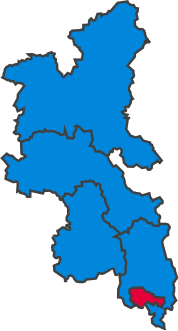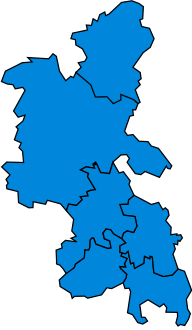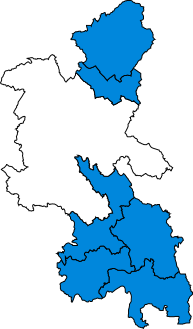|
Parliamentary constituencies in Buckinghamshire
 The ceremonial county of Buckinghamshire, which includes the unitary authorities of Buckinghamshire and the City of Milton Keynes, is divided into 8 parliamentary constituencies – 1 borough constituency and 7 county constituencies. At the 2024 general election, the county returned 5 Labour MPs, 2 Conservatives and 1 Liberal Democrat.[1] ConstituenciesConservative † Labour ‡ Liberal Democrat ¤
Boundary changes2024For the 2023 Periodic Review of Westminster constituencies, which redrew the constituency map ahead of the 2024 United Kingdom general election, the Boundary Commission for England proposed that the number of seats in the combined area of Buckinghamshire and Milton Keynes be increased from seven to eight with the creation of a new cross-authority constituency named Buckingham and Bletchley. This led to significant changes elsewhere, with Milton Keynes Central replacing Milton Keynes South and Mid Buckinghamshire replacing the existing Buckingham seat.[3][4] These changes came into effect for the 2024 general election.
2010Under the Fifth Periodic Review of Westminster constituencies, the Boundary Commission for England[5] decided to retain Buckinghamshire's constituencies for the 2010 election, making minor changes to realign constituency boundaries with the boundaries of current local government wards, and to reduce the electoral disparity between constituencies. The changes included the return of Great Missenden to Chesham and Amersham, Hazlemere to Wycombe and Aston Clinton to Buckingham. In addition, Marlow was transferred from Wycombe to Beaconsfield and Princes Risborough from Aylesbury to Buckingham. The boundary between the two Milton Keynes constituencies was realigned and they were renamed as Milton Keynes North and Milton Keynes South.
Results historyPrimary data source: House of Commons research briefing - General election results from 1918 to 2019[6] 2024The number of votes cast for each political party who fielded candidates in constituencies comprising Buckinghamshire in the 2024 general election were as follows:[1]
2019The number of votes cast for each political party who fielded candidates in constituencies comprising Buckinghamshire in the 2019 general election were as follows:
Percentage votesNote that before 1983 Buckinghamshire included the Eton and Slough areas of what is now Berkshire.
1pre-1979: Liberal Party; 1983 & 1987 - SDP-Liberal Alliance 22019: Standing as the Brexit Party. 3Standing in Buckingham, unopposed by the 3 main parties. 4Including Workers Party of Britain. * Included in Other Accurate vote percentages for the 1918 election cannot be obtained because some candidates stood unopposed. Seats
Maps1885-1910
1918-1945
1950-1979
1983-present
Historical representation by partyA cell marked → (with a different colour background to the preceding cell) indicates that the previous MP continued to sit under a new party name. 1885 to 1945Conservative Liberal Liberal Unionist
1945 to 1983
1983 to presentConservative Independent Labour Speaker Liberal Democrats
See also
NotesReferences
|
|||||||||||||||||||||||||||||||||||||||||||||||||||||||||||||||||||||||||||||||||||||||||||||||||||||||||||||||||||||||||||||||||||||||||||||||||||||||||||||||||||||||||||||||||||||||||||||||||||||||||||||||||||||||||||||||||||||||||||||||||||||||||||||||||||||||||||||||||||||||||||||||||||||||||||||||||||||||||||||||||||||||||||||||||||||||||||||||||||||||||||||||||||||||||||||||||||||||||||||||||||||||||||||||||||||||||||||||||||||||||||||||||||||||||||||||||||||||||||||||||||||||||||||||||||||||||||||||||||||||||||||||||||||||||||||||||||||||||||||||||||||||||||||||||||||||||||||||||||||||||||||||||||||||||||||||||||||||||||||||||||||||||||||||||||||||||||||||||||||||||||||||||||||||||||||||||||||||||||||||||||||||||||||||||||||||||||||||||||||||||||||||||||||||||||||||||||||||||||||||||||||||||||||||||||||||||||||||||||||||||||||||||||||||||||






























